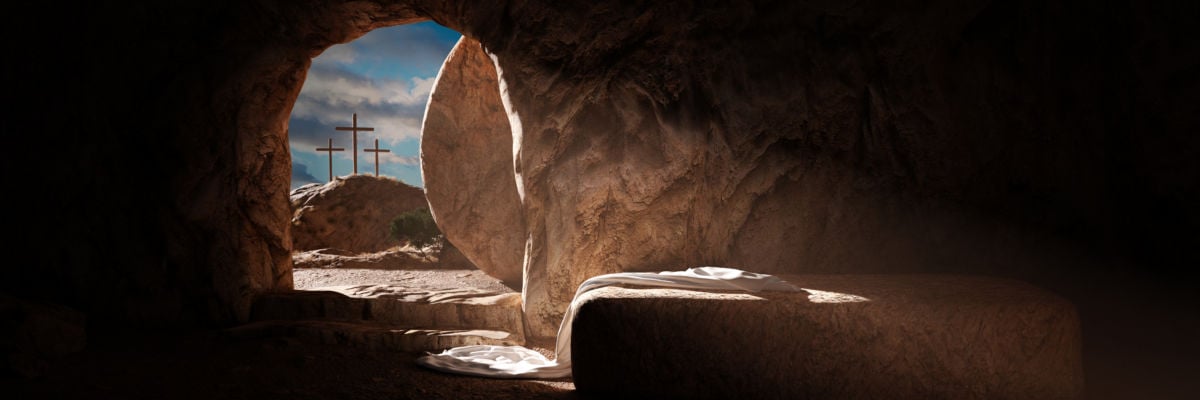
Episode 20: Year A – Easter Vigil
In this episode of the Sunday Catholic Word, we focus specifically on the Gospel reading for the Easter Vigil Mass because it relates directly to the solemnity that we celebrate this upcoming Sunday, the Resurrection of our Lord. The passage comes from Matthew 28:1-10. We pick out five details in the narrative that skeptics point to as evidence that the Gospel accounts of Jesus’ resurrection aren’t trustworthy.
Looking for Sunday Catholic Word Merchandise? Look no further! https://shop.catholic.com/catholic-answers-merchandise/?q=sunday
Hey everyone,
Welcome to The Sunday Catholic Word, a podcast where we reflect on the upcoming Sunday Mass readings and pick out the details that are relevant for explaining and defending our Catholic faith.
I’m Karlo Broussard, staff apologist and speaker for Catholic Answers, and the host for this podcast.
In this episode, we’re going to focus specifically on the Gospel reading for the Easter Vigil Mass because it directly relates to the solemnity that we celebrate this upcoming Sunday, the Resurrection of our Lord. The passage comes from Matthew 28:1-10. Here’s what we read:
After the sabbath, as the first day of the week was dawning, Mary Magdalene and the other Mary came to see the tomb. 2 b And behold, there was a great earthquake; for an angel of the Lord descended from heaven, approached, rolled back the stone, and sat upon it. 3 His appearance was like lightning and his clothing was white as snow. 4 The guards were shaken with fear of him and became like dead men. 5 Then the angel said to the women in reply, “Do not be afraid! I know that you are seeking Jesus the crucified. 6 He is not here, for he has been raised just as he said. Come and see the place where he lay. 7 Then go quickly and tell his disciples, ‘He has been raised from the dead, and he is going before you to Galilee; there you will see him.’ Behold, I have told you.” 8 Then they went away quickly from the tomb, fearful yet overjoyed, and ran to announce this to his disciples. 9 And behold, Jesus met them on their way and greeted them. They approached, embraced his feet, and did him homage. 10 Then Jesus said to them, “Do not be afraid. Go tell my brothers to go to Galilee, and there they will see me.”
There are five details in this passage that are relevant for apologetics, all of which have to do with alleged mishaps on Matthew’s part in relation to other Gospel accounts of the resurrection.
It’s common for Christian skeptics to claim that the Gospels in their reports about Jesus’ resurrection are contradictory. Agnostic New Testament scholar Bart Ehrman says they’re “hopelessly contradictory” (The Historical Jesus).
In his 2006 debate with William Lane Craig, Ehrman gives what I see as five discrepancies that he thinks support his claim. Each have to do with this Gospel reading.
The Number of Women in the Tomb
The first alleged discrepancy deals with Matthew’s mention of Mary Magdalene being among other women, a detail that is also found in Mark and Luke’s version of the event (Mark 16:1-3; Luke 24:10). But John only records Mary Magdalene as going to the tomb (John 20:1). So, which is it? Did Mary go alone? Or did she go with other women?
Our first response is that the objection falsely assumes that John was intending to say Mary Magdalene was the only woman. John merely showcases Mary Magdalene without any mention of the other women. And just because an account is incomplete, it doesn’t follow that it’s in error. Even Luke doesn’t give a complete account of the women that went to the tomb (24:10).
A second response is that John’s later account of Mary’s response to Peter and John indicates that he knew other women were with her: “she ran . . . and said to them . . . we do not know where they have laid him” (John 20:2; emphasis added). This would fit with Matthew’s reference to more than one woman. Luke employs a similar tactic when he first showcases Peter going to the tomb (Luke 24:12), but then later informs his reader that others had gone as well (Luke 24:24).
Sight of the Stone Rolled Away
Discrepancy 2 focuses on Matthew’s report that the women seemingly see the angel roll away the stone (28:2). The problem arises when we consider that Mark (16:3-4) and Luke (24:2) record the women finding the stone already rolled away.
Once again, the objection makes a false assumption—namely, that Matthew is intending to assert that the women witnessed the angel rolling away the stone. When we examine the text closer, we see something else.
First, as A. Jones argues in A Catholic Commentary on Holy Scripture the entire passage concerning the angel, the stone, and the guards who “trembled and became like dead men” (Matt. 28:2-4) seems to be a parenthetical statement. It’s unlikely that the women would have conversed with the angel while the guards lay there as dead.
Second, the details concerning the angel and the stone are introduced with the Greek conjunction gar: “And behold, there was a great earthquake; for [Gr. gar] an angel of the Lord descended from heaven and came and rolled back the stone, and sat upon it” (28:2; emphasis added).
Such an explanatory conjunction is used to introduce a clarification of a previous part of the sentence. For Matthew, the angel rolling away the stone is his explanation for the earthquake, not to assert that the women witnessed a stone-moving spectacle.
This answer could be further supported by the Greek, which could be rendered as the simple past, and thus translated as “an earthquake had occurred.” This would imply that women didn’t witness it.
Even the angel’s descent can be described as having already occurred according to the Greek, which can be translated: “for an angel of the Lord had descended” (28:2; International Standard Version, emphasis added).
“But wait a minute,” you ask, “how did Matthew know about this stuff if the women didn’t see it happen?”
It’s possible that Matthew received the details from the same source he received information about the conspiracy theory that the guards and the Jewish rulers made up (Matt. 28:11-15). If the empty tomb was part of the guards’ story of “all that had taken place” (28:11), then it’s possible the details in the parenthetical statement (vv.2-4) were part of it as well.
Men and Angels
Discrepancy 3 states that Mark (Matt. 16:5-6) and Luke (Luke 24:4) record that two men were sitting at the tomb, and Matthew says here in the Gospel reading that it was an angel (Matt. 28:5), which contradicts John’s account of two angels being present (John 20:11-13). So, are they angels or men? And how many were there? Two or one?
First, that some reports say men were present, and others say angels were present, in no way makes for a contradiction. It’s plausible to suggest that Mark and Luke describe what the women saw (“men”) without any intention to suggest what they were. Recall that angels often appear as men (Gen. 18:1-2; Heb. 13:2). Matthew and John, on the other hand, give an interpretation (perhaps the women’s own interpretation) of what the women saw (“angels”).
Concerning how many were present, Matthew and Mark showcase the one who spoke to the women, and simply omit the other. And as mentioned before, just because a report omits some details, it doesn’t follow the report denies those details.
Sight of Jesus
Discrepancy 4 states that Matthew (Matt. 28:16), along with John (John 21:1), report that the disciples went to Galilee as Jesus instructed (Matt. 28:7), but Mark and Luke don’t mention it: they only report that Jesus appeared to them in Jerusalem, after which Jesus ascends into heaven.
For a contradiction to hold, Luke and Mark would have to have said something like, “Jesus did not appear, or only appeared, to the apostles in Galilee.” But Luke or Mark never says this. They simply omit the detail from their narratives. Once again, to omit a detail and to deny a detail are not the same. Since it’s only an omission on the part of Mark and Luke, there’s no contradiction.
The Women Speaking
Discrepancy 5 focuses on Matthew’s report that the women went and told the disciples what they had seen and heard (Matt. 28:8), a detail that is confirmed by Luke (Luke 24:10-11). But Mark reports the women “said nothing to anyone” (Mark 16:8) because they were afraid (Mark 16:8). So did they speak or not?
A reasonable reading of Mark’s report is that the women ran straight to where the disciples were gathered without stopping to speak to anyone on the way. This is supported by Mark’s explanation that the women fled from the tomb “trembling,” and that “astonishment had come upon them” and “they were afraid” (Mark 16:8). Such fear would account for why they would not be inclined to talk to anyone as they were fleeing. Moreover, Mark explicitly tells us that Mary “went and told those who had been with him” (Mark 16:10).
Conclusion
Although the above responses do not give positive evidence that the Gospel writers are reliable in their reports about Jesus’ resurrection, they do show that one cannot reasonably reject their reports because they are “hopelessly contradictory”—to use Ehrman’s words. And given that such an obstacle is removed, one at least can be more open to accept them as trustworthy. And that’s at least a step in the right direction toward having faith in Christ. This is how apologetics fits within the apostolic commission to make disciples—removing obstacles to faith in Christ.
Well, my friends, that does it for this episode of the Sunday Catholic Word. You are now equipped to defend the resurrection narratives in the Gospels against any skeptic who might want to challenge them.
Thank you for subscribing to the podcast. Please be sure to tell your friends about it and invite them to subscribe as well. Also, if you’re interested in getting some cool mugs and stickers with my logo, “Mr. Sunday podcast,” go to shop.catholic.com.
I hope you have a blessed Easter Weekend.



